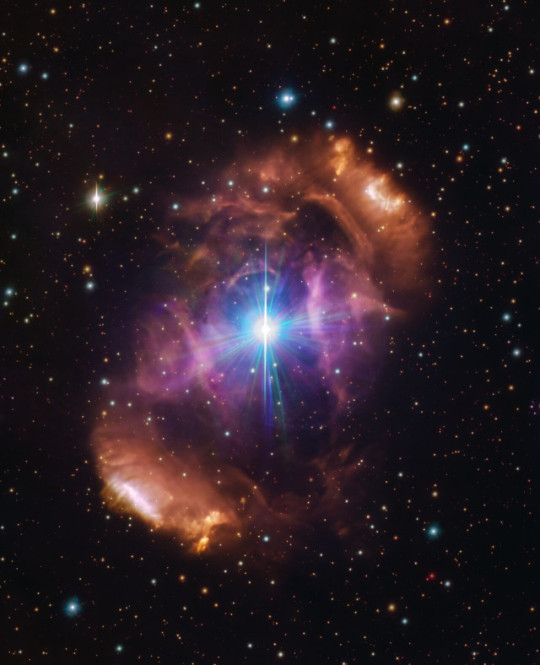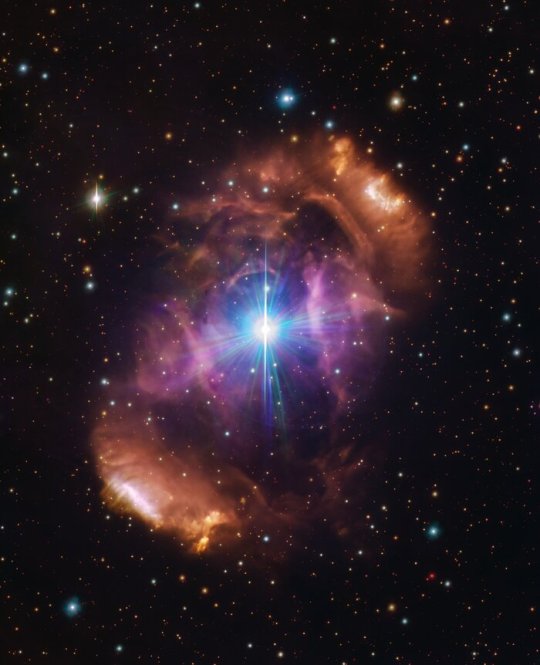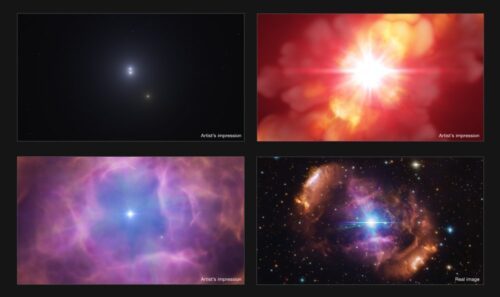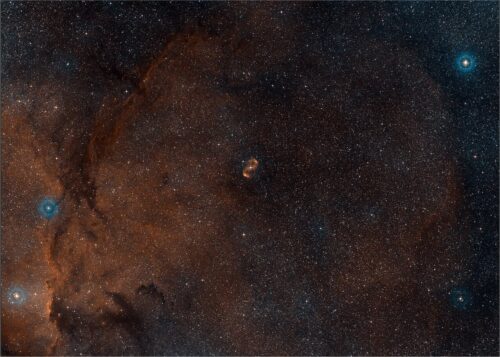#HD 148937
Text

An article published in the journal "Science" reports a study on the HD 148937 system, a binary system surrounded by a double nebula known as NGC 6164/6165. A team of researchers used the PIONIER and GRAVITY instruments mounted on ESO's VLT Interferometer (VLTI) in Chile and archival data from the FEROS instrument at the La Silla Observatory, also an ESO's telescope in Chile, to collect the data necessary to conclude that it was originally at least a triple system and at some point two of the stars merged. It was a violent event that created the cloud of materials around the system.
13 notes
·
View notes
Text

This image, taken with the VLT Survey Telescope hosted at ESO’s Paranal Observatory, shows the beautiful nebula NGC 6164/6165, also known as the Dragon’s Egg. The nebula is a cloud of gas and dust surrounding a pair of stars called HD 148937.
In a new study using ESO data, astronomers have shown that the two stars are unusually different from each other — one appears much younger and, unlike the other, is magnetic. Moreover, the nebula is significantly younger than either star at its heart, and is made up of gases normally found deep within a star and not on the outside. These clues together helped solve the mystery of the HD 148937 system — there were most likely three stars in the system until two of them clashed and merged, creating a new, larger and magnetic star. This violent event also created the spectacular nebula that now surrounds the remaining stars. Credit:
Credit: ESO
1K notes
·
View notes
Photo

2024 April 24
Dragon's Egg Bipolar Emission Nebula
Image Credit & Copyright: Rowan Prangley
Explanation: How did a star form this beautiful nebula? In the middle of emission nebula NGC 6164 is an unusually massive star. The central star has been compared to an oyster's pearl and an egg protected by the mythical sky dragons of Ara. The star, visible in the center of the featured image and catalogued as HD 148937, is so hot that the ultraviolet light it emits heats up gas that surrounds it. That gas was likely thrown off from the star previously, possibly the result of a gravitational interaction with a looping stellar companion. Expelled material might have been channeled by the magnetic field of the massive star, in all creating the symmetric shape of the bipolar nebula. NGC 6164 spans about four light years and is located about 3,600 light years away toward the southern constellation Norma.
∞ Source: apod.nasa.gov/apod/ap240424.html
121 notes
·
View notes
Text
https://www.reuters.com/science/astronomers-unravel-mystery-dragons-egg-nebula-2024-04-11/
Astronomers unravel the mystery of the 'Dragon's Egg' nebula

The nebula NGC 6164/6165, also known as the Dragon's Egg, a cloud of gas and dust surrounding a pair of stars called HD 148937, is seen in this undated handout image taken with the VLT Survey Telescope hosted at the European Southern Observatory's Paranal Observatory in Cerro Paranal, Chile.
WASHINGTON, April 11 (Reuters) - Two large stars residing inside a spectacular cloud of gas and dust nicknamed the "Dragon's Egg" nebula have presented a puzzle to astronomers. One of them has a magnetic field, as does our sun. Its companion does not. And such massive stars are not usually associated with nebulae.
Researchers now appear to have resolved this mystery while also explaining how the relatively few massive stars that are magnetic got that way. Blame it on stellar fratricide, they said. In this case, the bigger star apparently gobbled up a smaller sibling star, and the mixing of their stellar material during this hostile takeover created a magnetic field.
"This merger was likely very violent. When two stars merge, material can be thrown out, and this likely created the nebula we see today," said Chile-based European Southern Observatory astronomer Abigail Frost, lead author of the study published on Thursday in the journal Science.
Computer simulations previously had predicted that the blending of stellar material during such a merger could create a magnetic field in the combined star born in this process.
"Our study is the observational smoking gun confirming this scenario," said astronomer Hugues Sana of KU Leuven in Belgium, the study's senior author.
These two stars - gravitationally bound to each other in what is called a binary system - are located in our Milky Way galaxy about 3,700 light-years from Earth in the constellation Norma. A light-year is the distance light travels in a year, 5.9 trillion miles (9.5 trillion km).
The researchers used nine years of observations by the Chile-based Very Large Telescope.
The magnetic star is about 30 times more massive than the sun. Its remaining companion is about 26.5 times more massive than the sun. They orbit at a distance from each other varying from seven to 60 times the distance between Earth and the sun.
The Dragon's Egg is so named because it is located relatively near a larger nebula complex called the Fighting Dragons of Ara. The stars inside the Dragon's Egg appear to have started out 4-6 million years ago as a triple system - three stars born at the same time and gravitationally bound.
The triple system's two innermost members included a larger star - perhaps 25 to 30 times the mass of the sun - and a smaller one - maybe five to 10 times the sun's mass.
The more massive one evolved more quickly than the other, with its outer layer engulfing the smaller star and triggering a merger that ejected into space the gas and dust that make up the nebula, the researchers said.
This occurred very recently in a cosmic time scale - about 7,500 years ago, based on the expansion velocity of the material in the nebula. It consists of mostly hydrogen and helium, but also an unusually large amount of nitrogen, thanks to the merger.
Many sun-sized stars generate magnetic fields.
"For low-mass stars like our sun, convective heating - like the movement of hot water in a radiator in your home - creates a movement of stellar material. This in turn creates a dynamo effect which induces a magnetic field," Frost said.
"However, for massive stars - greater than eight times the mass of our sun - different heating effects are in play, and so explaining the presence of magnetic fields for these types of stars is more tricky. This merger scenario ticks all the boxes," Frost added.
About 7% of massive stars are known to have a magnetic field. The second star in this binary system, uninvolved in the violent merger, does not.
Stellar magnetic fields store immense amounts of energy. The sun's magnetic storms can interact with Earth's atmosphere and create our planet's thrilling auroras, but also can disrupt radio signals and navigation systems.
An image of the nebula released with the study is visually striking.
"The richness of the physics and chemistry at play gave rise to a beautiful structure," Sana said.
2 notes
·
View notes
Text
Choque Estelar Revela Segredo Cósmico a 3,8 mil Anos-luz
Um intrigante mistério cósmico foi desvendado por cientistas do Observatório Europeu do Sul (ESO) no sistema estelar HD 148937, situado a aproximadamente 3,8 mil anos-luz de distância da Terra. A descoberta, detalhada na revista Science, revela como o destino desse sistema foi alterado para sempre pelo choque e fusão de suas estrelas.
A nebulosa misteriosa que envolve o HD 148937 há muito…

View On WordPress
0 notes
Text
Nace nebulosa rara tras choque de estrellas masivas a 3 mil 800 años luz de la Tierra
Un equipo de astrónomos del @ESO revelaron la violenta historia de la hermosa nebulosa HD 148937 en donde un choque de estrellas resuelve un misterio estelar.
Agencias/Ciudad de México.- Un sistema a 3,800 años luz de la Tierra formado por dos estrellas mucho más masivas que el Sol está extrañamente rodeado por una hermosa nebulosa, una nube de gas y polvo.
Los pares de estrellas suelen ser muy similares, como los gemelos, pero en este sistema, HD 148937, una de las estrellas parece más joven y, a diferencia de su compañera, es magnética.
Nuevos datos…

View On WordPress
0 notes
Text
Bella nebulosa con una storia violenta
Questa immagine, scattata con il VLT Survey Telescope ospitato presso l’Osservatorio Paranal dell’ESO, mostra la bellissima nebulosa NGC 6164/6165, nota anche come Uovo del Drago. La nebulosa è una nube di gas e polvere che circonda una coppia di stelle chiamata HD 148937.
Quando gli astronomi hanno osservato una coppia stellare nel cuore di una straordinaria nube di gas e polvere, hanno avuto…

View On WordPress
0 notes
Text
ESO: Merger of 2 stars creates a magnetic star and a nebula
The latest report from the European Southern Observatory (ESO):
Beautiful nebula, violent history:
clash of stars solves stellar mystery

This image, taken with the VLT Survey Telescope hosted at ESO’s Paranal Observatory, shows the beautiful nebula NGC 6164/6165, also known as the Dragon’s Egg. The nebula is a cloud of gas and dust surrounding a pair of stars called HD 148937. In a new study using ESO data, astronomers have shown that the two stars are unusually different from each other — one appears much younger and, unlike the other, is magnetic. Moreover, the nebula is significantly younger than either star at its heart, and is made up of gases normally found deep within a star and not on the outside. These clues together helped solve the mystery of the HD 148937 system — there were most likely three stars in the system until two of them clashed and merged, creating a new, larger and magnetic star. This violent event also created the spectacular nebula that now surrounds the remaining stars.
Credit: ESO/VPHAS+ team. Acknowledgement: CASU
When astronomers looked at a stellar pair at the heart of a stunning cloud of gas and dust, they were in for a surprise. Star pairs are typically very similar, like twins, but in HD 148937, one star appears younger and, unlike the other, is magnetic. New data from the European Southern Observatory (ESO) suggest there were originally three stars in the system, until two of them clashed and merged. This violent event created the surrounding cloud and forever altered the system’s fate.
“When doing background reading, I was struck by how special this system seemed,”
says Abigail Frost, an astronomer at ESO in Chile and lead author of the study published today in Science. The system, HD 148937, is located about 3800 light-years away from Earth in the direction of the Norma constellation. It is made up of two stars much more massive than the Sun and surrounded by a beautiful nebula, a cloud of gas and dust.
“A nebula surrounding two massive stars is a rarity, and it really made us feel like something cool had to have happened in this system. When looking at the data, the coolness only increased.”
https://youtu.be/1pPnHX4YukE
“After a detailed analysis, we could determine that the more massive star appears much younger than its companion, which doesn't make any sense since they should have formed at the same time!”
The age difference — one star appears to be at least 1.5 million years younger than the other — suggests something must have rejuvenated the more massive star.

This collection of panels shows three artist’s impressions depicting the violent event that changed the fate of the stellar system HD 148937; a real astronomical image is shown in the last panel. Originally, the system had at least three stars (top left panel), two of them close together and another one much more distant, until one day the two inner stars clashed and merged (top right panel). This violent event created a new, larger and magnetic star, now in a pair with the more distant one (bottom left panel). The merger also released the materials that created the spectacular nebula now surrounding the stars (bottom right panel).Credit: ESO/L. Calçada, VPHAS+ team. Acknowledgement: CASU
Another piece of the puzzle is the nebula surrounding the stars, known as NGC 6164/6165. It is 7500 years old, hundreds of times younger than both stars. The nebula also shows very high amounts of nitrogen, carbon and oxygen. This is surprising as these elements are normally expected deep inside a star, not outside; it is as if some violent event had set them free.
To unravel the mystery, the team assembled nine years' worth of data from the PIONIER and GRAVITY instruments, both on ESO’s Very Large Telescope Interferometer (VLTI), located in Chile’s Atacama Desert. They also used archival data from the FEROS instrument at ESO’s La Silla Observatory.
“We think this system had at least three stars originally; two of them had to be close together at one point in the orbit whilst another star was much more distant,”
explains Hugues Sana, a professor at KU Leuven in Belgium and the principal investigator of the observations.
“The two inner stars merged in a violent manner, creating a magnetic star and throwing out some material, which created the nebula. The more distant star formed a new orbit with the newly merged, now-magnetic star, creating the binary we see today at the centre of the nebula.”
https://youtu.be/DfYV0cZ9Ym0
“The merger scenario was already in my head back in 2017 when I studied nebula observations obtained with the European Space Agency’s Herschel Space Telescope,”
“Finding an age discrepancy between the stars suggests that this scenario is the most plausible one and it was only possible to show it with the new ESO data.”
This scenario also explains why one of the stars in the system is magnetic and the other is not — another peculiar feature of HD 148937 spotted in the VLTI data.
At the same time, it helps solve a long-standing mystery in astronomy: how massive stars get their magnetic fields. While magnetic fields are a common feature of low-mass stars like our Sun, more massive stars cannot sustain magnetic fields in the same way. Yet some massive stars are indeed magnetic.

This wide-field view, created from images forming part of the Digitized Sky Survey 2, shows the rich star clouds in the constellation of Norma (the Carpenter’s Square) in our Milky Way galaxy. The beautiful nebula NGC 6164/6165, also known as the Dragon’s Egg, appears in the centre of the image. Credit: ESO/Digitized Sky Survey 2. Acknowledgement: Davide De Martin
Astronomers had suspected for some time that massive stars could acquire magnetic fields when two stars merge. But this is the first time researchers find such direct evidence of this happening. In the case of HD 148937, the merger must have happened recently.
“Magnetism in massive stars isn't expected to last very long compared to the lifetime of the star, so it seems we have observed this rare event very soon after it happened,”
Frost adds.
ESO’s Extremely Large Telescope (ELT), currently under construction in the Chilean Atacama Desert, will enable researchers to work out what happened in the system in more detail, and perhaps reveal even more surprises.
Links
- Research paper (preprint; for the final version of the embargoed paper, please check https://www.eurekalert.org/press/scipak/ or contact [email protected] while the embargo lasts)
- Photos of the VLT/VLTI
- Find out more about ESO's Extremely Large Telescope on our dedicated website and press kit
- For journalists: subscribe to receive our releases under embargo in your language
- For scientists: got a story? Pitch your research
=== Amazon Ads ===
Celestron - NexStar 130SLT Computerized Telescope -
Compact and Portable -
Newtonian Reflector Optical Design -
SkyAlign Technology -
Computerized Hand Control -
130mm Aperture
====
An Infinity of Worlds:
Cosmic Inflation and the Beginning of the Universe
Read the full article
0 notes
Photo




So there are high gravity planets in Elite: Dangerous. HD 148937 so far is the highest at 9.77G (almost 10 times Earths normal gravity). It’s a dangerous thing to land and to escape its pull but it’s one hell of a sight.
1 note
·
View note
Photo

NGC6188 aka The fighting dragons of ara, is an emission nebula located about 4,000 light years away in the constellation Ara. The bright open cluster NGC 6193, visible to the naked eye, is responsible for a region of reflection nebulosity within NGC 6188. NGC 6188 is a star forming nebula, and is sculpted by the massive, young stars that have recently formed there – some are only a few million years old. This spark of formation was probably caused when the last batch of stars went supernova. Image also show NGC 6164 which is a bipolar emission nebula of about 4 light-years across that lies some 4,200 light-years away in the southern constellation of Norma. It is approaching us at approximately 53.9 kilometers per second. Its symmetric gaseous shroud and faint halo surround the blue, young, central star HD 148937, the brightest member of a triple star system orbiting around each other, which fierce stellar winds – of about 8 million kilometers per hour – created this nebula. Swipe left to see more details of this beautiful region in Ha. If you look closely you can just make our the beautiful shells of NGC 6164 📷: 1 hour of 12nm Ha data with 30min of RGB with modded and stock 6D 🔭: AT65EDQ on @ioptron_telescopes Sky guider pro (at Tauranga, New Zealand) https://www.instagram.com/p/CFoWb10p_y1/?igshid=1isqgpo5xs65o
0 notes
Photo

MX-811 "Citlallicue" - Location HD 148937 Log entry<<: Finally, after all tests, I am leaving this system. I made several runs on "approach and land" process in the High G planet here. After my initial attempt I was able to touchdown without popping the shields and I am quite happy with this ship performance. Here are some postals from this wonderful planet and this awesome system. 5 Stars orbiting a big O Class star. Now, I am pointing to a actual long range destination. ETA CARINAE Nebula, there are reports of amazing points of interest, and some Guardian Ancient Ruins. I will report back once I am closer or if anything unusual happens. >>Finish Log #elitedangerous #elitedangerousexploration #stellarscreenshots #spaceexploration https://www.instagram.com/p/CBVw5T2J6UU/?igshid=c0oly8opcjye
0 notes
Text

Un articolo pubblicato sulla rivista "Science" riporta uno studio sul sistema HD 148937, un sistema binario circondato da una doppia nebulosa conosciuta come NGC 6164/6165. Un team di ricercatori ha usato gli strumenti PIONIER e GRAVITY montati sull'interferometro del VLT (VLTI) dell'ESO in Cile e dati dell'archivio dello strumento FEROS all'Osservatorio di La Silla, anch'esso dell'ESO in Cile, per raccogliere i dati necessari a concludere che in origine si trattava almeno di un sistema triplo e a un certo punto due delle stelle si sono fuse. Si è trattato di un evento violento che ha creato la nube di materiali attorno al sistema.
2 notes
·
View notes
Text
Сражающиеся драконы и космический цветок: красочная панорама туманностей NGC 6188 и NGC 6164!
http://popular-astronomy.ru
Справа видна NGC 6188 из созвездия Жертвенника. Эта эмиссионная туманность находится на краю большого молекулярного облака, на расстоянии около 4 тысяч световых лет от Земли. Ее окружают молодые массивные звёзды ассоциации Жертвенник ОВ1, которые своими звёздными ветрами создают формы газопылевых облаков и заставляют светиться межзвёздный газ.
Слева - туманность NGC 6164 из созвездия Наугольника, которая находится недалеко от NGC 6188. Она образована звёздным ветром горячей массивной звезды HD 148937, её возраст - от 3 до 4 миллионов лет. Туманность обладает биполярной симметрией, которая скорее всего вызвана магнитным полем звезды. Из-за этой симметрии её часто путают с планетарными туманностями.
0 notes
Photo

#elitedangerous #stellarscreenshots Federal Research Vessel MX-811 "Citlallicue". The ship bares the name of an Ancient Aztec Culture Godess, creator of the stars. It has been retrofited from a old mining ASP Explorer for long range exploration. After maiden flight it will continue into System HD 148937 (around 1400 ly from Sol) for High G environment tests. #lakonspaceways #spaceexploration https://www.instagram.com/p/CBCV8wHpU7a/?igshid=9v1g420smrm9
0 notes
Video
Final jump of the MX-811 Citlallicue to High G test field on HD 148937 System. #elitedangerous #elitedangerouscaptures #stellarscreenshots #spaceexploration https://www.instagram.com/p/CBH6aCsJ_uE/?igshid=1gl4luc4wrkhy
0 notes